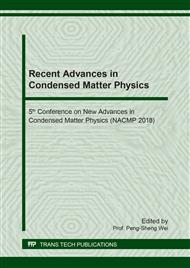[1]
Lei Tianmin, Wu Shengbao, Zhang Yuming, Liu Jiajia, Guo Hui, Zhang Zhiyong, Electronic structure and optical properties of monolayer MoS2, Rare Metal Materials and Engineering,42(2013) 2477-2480.
Google Scholar
[2]
L. I Ivanenko, V. L Shaposhnikov, A. B Filonov, A.VKrivosheeva, .E Borisenko, D. BMigas, LMiglio, GBehr, J Schumann, Electronic properties of semiconducting silicides: fundamentals and recent predictions, Thin Solid Films ,461(2004)141-147.
DOI: 10.1016/j.tsf.2004.02.088
Google Scholar
[3]
N. G. Galkin, T. V. Velitchko, S. V. Skripka, A. B. Khrustalev, Semiconducting and structural properties of CrSi2 A-type epitaxial films on Si(111). Thin solid films, 280(1996)211-220.
DOI: 10.1016/0040-6090(95)08241-7
Google Scholar
[4]
Shiyun Zhou, Quan Xie, Wanjun Yan, Qian Chen,The first principle of the electronic structure and optical properties of CrSi2, China calculation (series G: Physics, mechanics science and Astronomy), 39 (2009)175-180.
DOI: 10.1007/s11433-009-0016-2
Google Scholar
[5]
Yan Wanjun, Zhang Chunhon, et al, The optical-electrical properties of doped β-FeSi2, Journal of Semiconductors, 34(2013)103003-1-103003-7.
Google Scholar
[6]
Yooleemi Shin et al, New synthesis of MnSi2 thin film and its thermoelectric properties, Journal of Vacuum Science & Technology A: Vacuum, Surfaces, and Films, 33(2015), 061516-1-061516-5.
DOI: 10.1116/1.4932515
Google Scholar
[7]
Shinoda, S. Asanabe, and Y. Sasaki, Semiconducting Properties of Chromium Disilicide, J. Phys. Soc. Jpn. 19 (1964)269-272.
DOI: 10.1143/jpsj.19.269
Google Scholar
[8]
T. Siegrist, F. Hulliger and G. Travaglini, The crystal structure and some properties of ReSi2, Journal of the Less-Common Metals, 92 (1983) 119-129.
DOI: 10.1016/0022-5088(83)90233-3
Google Scholar
[9]
Bellan V. Guizzetti G. Marabell F,Theory and experiment on the optical properties of CrSi2,Phys Rev B, 461992)9380-9389.
Google Scholar
[10]
Krijn, M. P. C. M., Eppenga, R., First princiles electronic structure and optical properties of CrSi2, Phys Rev B, 44(1991)9042–9044.
Google Scholar
[11]
Bost M C, Mahan J E. An investigation of the optical constants and band gap of chromium disilicide, Journal of Applied Physics, 63(1988)839-844.
DOI: 10.1063/1.340078
Google Scholar
[12]
Zhao Jun, Zheng Hui. Two-dimensional germanane and germanane ribbons: density functional calculation of structural, electronic, optical and transport properties and the role of defects. RSC Adv., 6(2016), 28298- 28307.
DOI: 10.1039/c5ra23323b
Google Scholar
[13]
Wang, X. Q., Li, H. D., Wang, J. T., Induced ferromagnetism in one-side semihydrogenated silicene and germanene, Phys. Chem. Chem. Phys.14(2012),3031-3036.
DOI: 10.1039/c2cp23385a
Google Scholar
[14]
Zheng, F., Zhang, C., The electronic and magnetic properties of functionalized silicene: a first-principles study, Nanoscale Res. Lett. 7(2012)422.
DOI: 10.1186/1556-276x-7-422
Google Scholar
[15]
Zhang H, Liu L M, Lau W M. Dimension-dependent phase transition and magnetic properties of VS2. J Mater Chem A. ,1(2013)10821-10828.
DOI: 10.1039/c3ta12098h
Google Scholar
[16]
Nannan Han, Hongsheng Liu, Jijun Zhao, Novel Magnetic Monolayers of Transition Metal Silicide, 28(2015)1755-1758.
Google Scholar
[17]
P. Hohenberg, W. Kohn, Inhomogeneous electron gas, Phys. Rev. B.136(1964)864-871.
Google Scholar
[18]
W. Kohn, L. J. Sham, Self-consistent equations including exchange and correlation effects, Phys. Rev. A 140(1965)A1133- A1138.
DOI: 10.1103/physrev.140.a1133
Google Scholar
[19]
J. P. Perdew, K. Burke, M. Ernzerhof, Generalized gradient approximation made simple, Phys. Rev. Lett. 77 (1996)3865–3868.
DOI: 10.1103/physrevlett.77.3865
Google Scholar
[20]
M. C. Payne et al., Iterative minimization techniques for ab initio total-energy calculations: molecular dynamics and conjugate gradients, Rev. Mod. Phys. 64(1992)1064-1096.
DOI: 10.1103/revmodphys.64.1045
Google Scholar
[21]
S.J. Clark et al., First principles methods using {CASTEP}, Z. Kristall. 220(2005)567-570.
Google Scholar
[22]
G. Kresse, D. Joubert, Self-interaction correction to density-functional approximations for many-electron systems, Phys. Rev. B: Condens. Matter Mater. Phys. 59(1999)1758-1775.
Google Scholar


